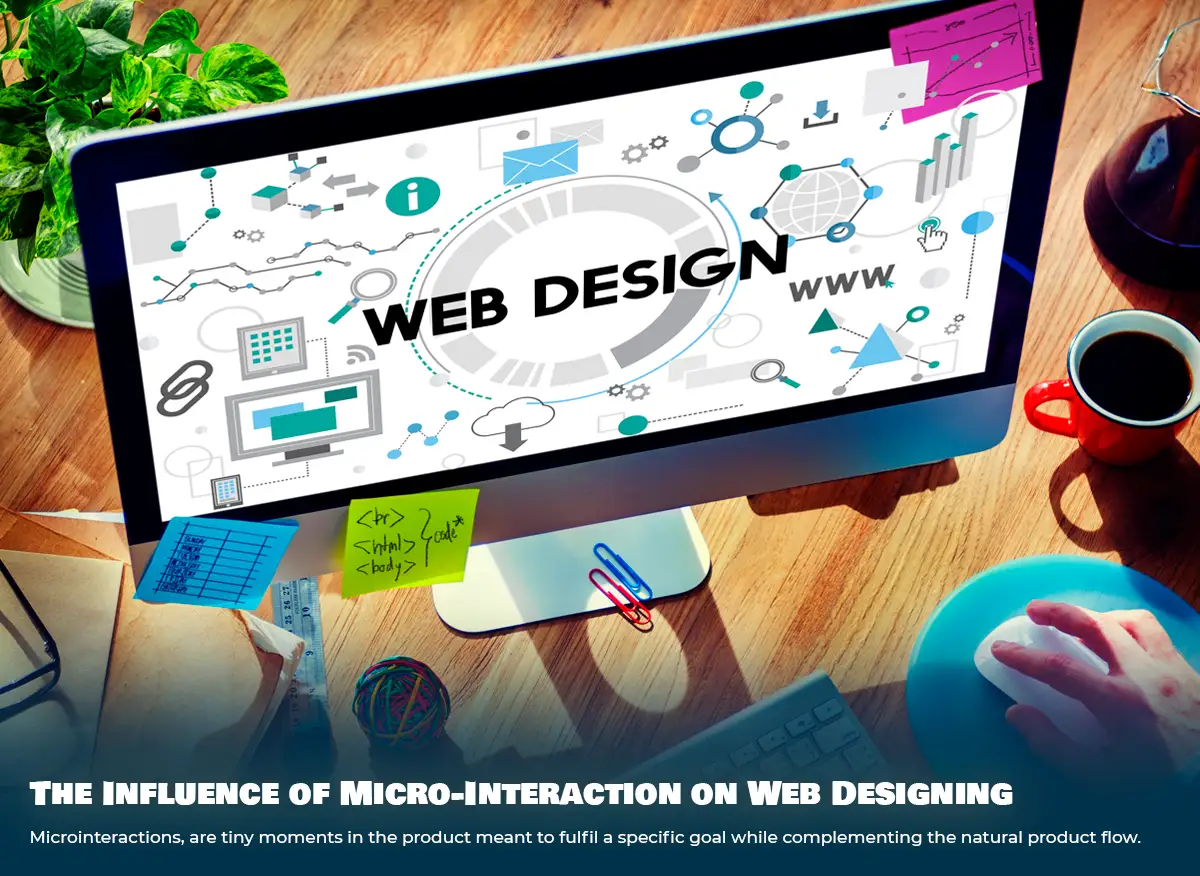Micro-interaction components of website design may not always represent huge symbols or images on a screen, but they play an important part in site navigation.
There are several approaches to improving the user experience while developing a product, including the use of personas, well-structured information architecture, and strategically produced content. Yet, once this high-level framework is established, it is up to the finer interaction design aspects to satisfy the user.
These nuances, known as micro-interactions, are tiny moments in the product meant to fulfil a specific goal while complementing the natural product flow. Swiping up to refresh data, enjoying the material, or altering a setting are all examples of micro-interactions. They can also contain simple UI motions, such as how a menu slides in when pressed or a card glides off the screen when swiped.

Let’s get an insight into micro-interaction :
What is micro-interaction:
The term “micro-interaction” refers to small moments that interact to complete a certain task. Engaging with a website utilising micro-interaction makes it easier for visitors to grasp the flow of the website and connect with its little features and motions.
When it comes to website design, we must be exact in our usage of micro-interactions in our UI/UX design since people will feel your website by connecting with your website and may transmit preventing mistakes and providing Assistance.
Users are delighted by micro-interaction, which creates an engrossing moment that encourages viewers to stay on the website for longer and utilise it for more beneficial purposes. This might further encourage the customer to do things like buy your goods, like your content in reverse, share, save, and comment on it.
Let’s learn about the Structure:
Every micro interaction consists of four components.
1. Trigger:
The micro-interactions are started by a trigger. Toggle switches, which turn features on and off, are one kind of trigger.
2. Rules:
A rule specifies what happens during a micro-interaction and controls how it reacts to a trigger. For instance, a torch app utilises a button as the trigger to switch on and off the light.
3. Feedback :
It informs the user of what transpired during the micro-interaction. A signup form with inline validation is an example of feedback; the border colour changes to green if the field is correctly filled out and to red if it is not. The user can then tell immediately away if anything is correct or incorrect.
4. Loops and Modes:
Loops and modes specify the meta-rules of the micro-interaction and how the micro-interaction varies over time. For instance, in eCommerce, if a customer has already purchased an item, the “Buy it now” button may change to “Buy another.”
Rules of Micro-interaction:
Movement in any digital product should be natural and easy for the consumer to predict. Poorly executed animation can quickly degrade our perception of the app. On the other hand, a little, nearly unnoticeable animation that is carefully designed and placed in the correct position may improve the reception of a product and guide the user to do some action.
Furthermore, it can offer the user visual feedback following a certain task or aid in the prevention of mistakes. As a result, the rules on how to build effective micro-interactions. These rules dictate how those interactions should take place.
Let’s discuss some of the rules of micro-interaction:
1. Functionality:
The goal of developing micro-interactions is to close the gap between user expectations and experience. Everything they do should feel as natural and intuitive as possible.
2. Conduct the research
Who are the intended users? What information do we have about them? Data collection will speed up the process and aid in the development of customised solutions.
3. Maintain simplicity
Overdesigning micro-interactions or including too many on a website while web development might be detrimental. This includes the animation span, which should be neither too lengthy nor too short. An animation that is too brief will be overlooked by the user, while one that is too long may imply that something is wrong with the product. It may frustrate and irritate the user in some way rather than being helpful and entertaining.
4. Generate harmony
Match the motions with other UI components so that they form a complete. It will improve the user experience and keep users interested.
5. Acquire user feedback
Real-world client feedback can help enhance the product. Listen to the target audience and get feedback. Afterwards, analyse what you’ve learned and make modifications to modernise and optimise the animations so they operate on every platform. You’re attempting to increase user engagement.
Benefits of using micro-interaction:
Micro-interactions are brief but significant interactions between a user and a digital interface. These interactions can be as basic as a button click or as complicated as a multi-step process, but the goal is to offer the user quick feedback and improve their overall experience. Incorporating micro-interactions into digital designs has several advantages.
Including micro-interaction in a product has several major advantages, including:
- Smoother UI interactions have a good emotional impact on the user
- Giving the user fast feedback in response to their actions
- Using a more fluid, intuitive approach to guiding the user through an app
- Requiring users to respond to notifications or share material in order to connect with an app
- Avoiding user mistakes
Conclusion:
Microinteractions are vital to a user’s understanding of computer systems. They provide the user with feedback, whether positive or negative, on the present state of the system, the outcome of their activities, or what has already occurred as a result of their actions, and advise them on what to do next.
Micro-interactions are the most effective for developing call-to-actions on landing pages. Because these page regions play such a crucial part in converting visitors into prospective or real customers, “Call to Action” micro-interactions may aid in encouraging an individual to do an action, such as registering, clicking for additional information, or sharing with others.